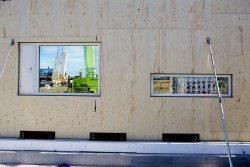Metsä Wood and its partners have designed a landmark hybrid sandwich wall panel that combines concrete with Kerto® LVL (laminated veneer lumber) to bring sustainable and efficient construction to the offsite arena.
The need for more sustainable solutions is acute with construction causing 30% of all carbon emissions. Combining concrete and Kerto® LVL, the hybrid sandwich wall panel offers an easy way to replace typical concrete sandwich elements, and can be used in residential, office or industrial multistorey buildings.
Metsä Wood partnered with Finnish construction and structural design companies to design the hybrid sandwich wall panel. Precast element manufacturer Lipa-Betoni saw the potential of the hybrid approach. “The hybrid sandwich wall element is a great opportunity. We look for a new market with a product, which can be used in the same way as concrete sandwich elements,” says Satu Lipsanen, CEO of Lipa-Betoni.
The starting point for the new element design, was a common residential seven-storey building with a concrete structure, including hollow-core slabs and party walls made from concrete. In the hybrid sandwich wall panel, the load-bearing internal panel is replaced with a Kerto® LVL Q-panel. Otherwise, the structure of the element remains the same – the façade is made from concrete and the element has an insulation layer.
“As a material, Kerto® LVL is very comparable with concrete,” says Ari Mättö, Structural Designer of JM-Rakenne Oy. “The compressive strength of the Kerto® LVL panel is as high as that of C25 concrete, 26 MPa. Also, the tensile strength of the panel is at the same level, whereas in concrete it is 10% of the compressive strength without steel reinforcement. In a hybrid sandwich element, the reinforcement is needed only in the façade.”
During construction, the loads are transferred from the external wall to the concrete structure to stiffen the building. The new element also provides effective insulation. By building a hybrid element from timber and concrete, the U-value can be 20% better. “The hybrid sandwich wall element helps to increase the share of wood to build more sustainable buildings efficiently,” says Jussi Björman, Director, Business Construction at Metsä Wood. “This joint development is our effort to support the construction industry.
Around one million square metres of concrete wall elements are produced annually in Finland. Their load-bearing core creates 45,000 tons of carbon emissions. If all concrete walls were replaced with hybrid sandwich wall elements, carbon emissions would decrease by 30,000 tons a year and 95,000 tons of carbon would be stored.”
The first hybrid sandwich wall panels will be produced at Lipa-Betoni's factory in Pieksämäki, Finland, for Metsä Fibre's Rauma sawmill construction project. Metsä Fibre’s new Rauma pine sawmill is the largest sawmill investment ever in Finland costing EUR 200million. The sawmill will produce around 750,000 cubic metres of pine sawn timber annually, with production set to begin during the third quarter of 2022.
On a global scale, the potential is huge. “Metsä Wood currently works with European and Australian companies to produce similar ideas that fit the local way of construction,” adds Björman. “Half a dozen designs are being prepared for publication this year. As Kerto® LVL is a light material, the hybrid sandwich wall elements will be faster to produce at the factory and transport to site, and even the transport emissions will decrease due to the light load. The light elements are also faster to lift.” The hybrid sandwich wall element designs are already available at the Open Source Wood platform, which aims at facilitating knowledge sharing, co-creation and growth in modular timber construction.
To read full article and for more news, check out the latest Offsite Magazine









